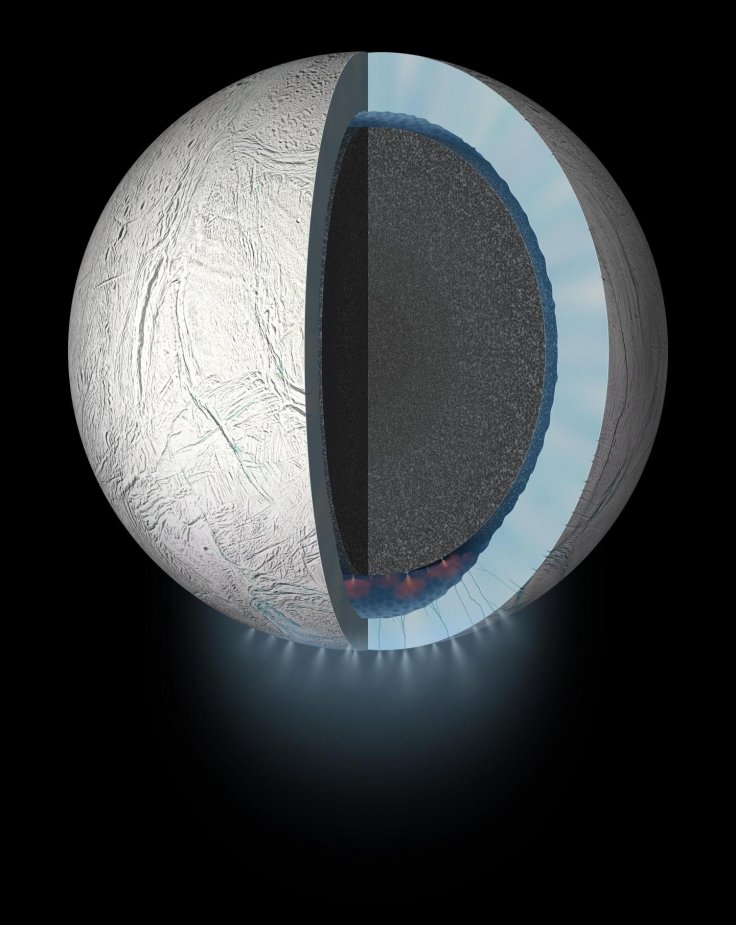A new study, published in Geophysical Research Letters, says a new geochemical model has revealed that carbon dioxide (CO2) from within Enceladus, an ocean-harboring moon of Saturn, may be controlled by chemical reactions at its seafloor. The Southwest Research Institute (SwRI) team studied the plume of gases and frozen sea spray released through cracks in the moon's icy surface and suggested that the interior of the planet is more complex than previously thought.
SwRI's Dr. Christopher Glein, the lead author of the paper, said: "By understanding the composition of the plume, we can learn about what the ocean is like, how it got to be this way and whether it provides environments where life as we know it could survive. We came up with a new technique for analyzing the plume composition to estimate the concentration of dissolved CO2 in the ocean. This enabled modeling to probe deeper interior processes."

Abundance of CO2
The researchers have analysed the mass spectrometry data from NASA's Cassini spacecraft that indicates the abundance of CO2 is best explained by geochemical reactions between the rocky core of the moon and liquid water from its subsurface ocean. The information when added to the earlier discoveries of silica and molecular hydrogen (H2), points to a more complex and geochemically diverse core.
Glein said: "Based on our findings, Enceladus appears to demonstrate a massive carbon sequestration experiment. On Earth, climate scientists are exploring whether a similar process can be utilized to mitigate industrial emissions of CO2. Using two different data sets, we derived CO2 concentration ranges that are intriguingly similar to what would be expected from the dissolution and formation of certain mixtures of silicon- and carbon-bearing minerals at the seafloor."
The researcher said the likely presence of hydrothermal vents inside Enceladus is another phenomenon that contributes to the complexity. The study explains that the hydrothermal vents present at the Earth's ocean floor emit hot, energy-rich, mineral-laden fluids that allow unique ecosystems teeming with unusual creatures to thrive.
"The dynamic interface of a complex core and seawater could potentially create energy sources that might support life," said SwRI's Dr. Hunter Waite, principal investigator of Cassini's Ion Neutral Mass Spectrometer (INMS). "While we have not found evidence of the presence of microbial life in the ocean of Enceladus, the growing evidence for chemical disequilibrium offers a tantalizing hint that habitable conditions could exist beneath the moon's icy crust."
Cassini's close flyby of Enceladus
The scientists continue to reap the benefits of Cassini's close flyby of Enceladus on October 28, 2015, prior to the end of the mission, that detected tiny particles of silica, two chemicals considered to be markers for hydrothermal processes.
Glein said: "Distinct sources of observed CO2, silica and H2 imply mineralogically and thermally diverse environments in a heterogeneous rocky core. We suggest that the core is composed of a carbonated upper layer and a serpentinized interior."
The study says that hydrothermal oxidation of reduced iron deep in the core creates H2, while hydrothermal activity intersecting quartz-bearing carbonated rocks produces silica-rich fluids. According to the researcher, these rocks also have potential to influence the CO2 chemistry of the ocean via low-temperature reactions involving silicates and carbonates at the seafloor.
"The implications for possible life enabled by a heterogeneous core structure are intriguing. This model could explain how planetary differentiation and alteration processes create chemical (energy) gradients needed by subsurface life," Glein added.









